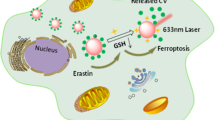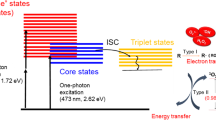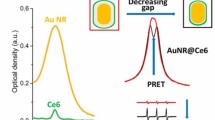Abstract
Gold nanostructures are among the noble metal nanomaterials being intensely studied due to their good biocompatibility, tunable localized surface plasmon resonance (SPR), and ease of modification. These properties give gold nanostructures many potential chemical and biomedical applications. Herein, we demonstrate the critical role of oxygen activation during the decomposition of hydrogen peroxide (H2O2) in the presence of photoexcited gold nanorods (AuNRs) by using electron spin resonance (ESR) techniques. Upon SPR excitation, O2 is activated first, and the resulting reactive intermediates further activate H2O2 to produce •OH. The reactive intermediates exhibit singlet oxygen-like (1O2-like) reactivity, indicated by 1O2-specific oxidation reaction, quenching behaviors, and the lack of the typical 1O2 ESR signal. In addition, by using the antioxidant sodium ascorbate (NaA) as an example, we show that hydroxyl radicals from H2O2 activation can induce much stronger NaA oxidation than that in the absence of H2O2. These results may have significant biomedical implications. For example, as oxidative stress levels are known to influence tumorigenesis and cancer progression, the ability to control redox status inside tumor microenvironments using noble metal nanostructures may provide new strategies for regulating the metabolism of reactive oxygen species and new approaches for cancer treatment.

Similar content being viewed by others
References
Linic, S.; Christopher, P.; Xin, H. L.; Marimuthu, A. Catalytic and photocatalytic transformations on metal nanoparticles with targeted geometric and plasmonic properties. Acc. Chem. Res. 2013, 46, 1890–1899.
Liz-Marzán, L. M.; Murphy, C. J.; Wang, J. F. Nanoplasmonics. Chem. Soc. Rev. 2014, 43, 3820–3822.
Clavero, C. Plasmon-induced hot-electron generation at nanoparticle/metal-oxide interfaces for photovoltaic and photocatalytic devices. Nat. Photonics 2014, 8, 95–103.
Linic, S.; Aslam, U.; Boerigter, C.; Morabito, M. Photochemical transformations on plasmonic metal nanoparticles. Nat. Mater. 2015, 14, 567–576.
Brongersma, M. L.; Halas, N. J.; Nordlander, P. Plasmoninduced hot carrier science and technology. Nat. Nanotechnol. 2015, 10, 25–34.
Fang, C. H.; Jia, H. L.; Chang, S.; Ruan, Q. F.; Wang, P.; Chen, T.; Wang, J. F. (Gold core)/(titania shell) nanostructures for plasmon-enhanced photon harvesting and generation of reactive oxygen species. Energy Environ. Sci. 2014, 7, 3431–3438.
Mukherjee, S.; Libisch, F.; Large, N.; Neumann, O.; Brown, L. V.; Cheng, J.; Lassiter, J. B.; Carter, E. A.; Nordlander, P.; Halas, N. J. Hot electrons do the impossible: Plasmon-induced dissociation of H2 on Au. Nano Lett. 2013, 13, 240–247.
Lee, J.; Mubeen, S.; Ji, X. L.; Stucky, G. D.; Moskovits, M. Plasmonic photoanodes for solar water splitting with visible light. Nano Lett. 2012, 12, 5014–5019.
Mubeen, S.; Lee, J.; Singh, N.; Krämer, S.; Stucky, G. D.; Moskovits, M. An autonomous photosynthetic device in which all charge carriers derive from surface plasmons. Nat. Nanotechnol. 2013, 8, 247–251.
Vankayala, R.; Sagadevan, A.; Vijayaraghavan, P.; Kuo, C. L.; Hwang, K. C. Metal nanoparticles sensitize the formation of singlet oxygen. Angew. Chem., Int. Ed. 2011, 50, 10640–10644.
Misawa, M.; Takahashi, J. Generation of reactive oxygen species induced by gold nanoparticles under x-ray and UV Irradiations. Nanomedicine 2011, 7, 604–614.
Pasparakis, G. Light-induced generation of singlet oxygen by naked gold nanoparticles and its implications to cancer cell phototherapy. Small 2013, 9, 4130–4134.
Gao, L.; Liu, R.; Gao, F. P.; Wang, Y. L.; Jiang, X. L.; Gao, X. Y. Plasmon-mediated generation of reactive oxygen species from near-infrared light excited gold nanocages for photodynamic therapy in vitro. ACS Nano 2014, 8, 7260–7271.
Labouret, T.; Audibert, J. F.; Pansu, R. B.; Palpant, B. Plasmon-assisted production of reactive oxygen species by single gold nanorods. Small 2015, 11, 4475–4479.
Huang, Y.-F.; Zhang, M.; Zhao, L.-B.; Feng, J.-M.; Wu, D. Y.; Ren, B.; Tian, Z.-Q. Activation of oxygen on gold and silver nanoparticles assisted by surface plasmon resonances. Angew. Chem., Int. Ed. 2014, 53, 2353–2357.
Long, R.; Mao, K. K.; Ye, X. D.; Yan, W. S.; Huang, Y. B.; Wang, J. Y.; Fu, Y.; Wang, X. S.; Wu, X. J.; Xie, Y. et al. Surface facet of palladium nanocrystals: A key parameter to the activation of molecular oxygen for organic catalysis and cancer treatment. J. Am. Chem. Soc. 2013, 135, 3200–3207.
Daniel, M.-C.; Astruc, D. Gold nanoparticles: Assembly, supramolecular chemistry, quantum-size-related properties, and applications toward biology, catalysis, and nanotechnology. Chem. Rev. 2004, 104, 293–346.
Gong, J. L.; Mullins, C. B. Surface science investigations of oxidative chemistry on gold. Acc. Chem. Res. 2009, 42, 1063–1073.
Chen, H. J.; Shao, L.; Li, Q.; Wang, J. F. Gold nanorods and their plasmonic properties. Chem. Soc. Rev. 2013, 42, 2679–2724.
Vijayaraghavan, P.; Liu, C.-H.; Vankayala, R.; Chiang, C.-S.; Hwang, K. C. Designing multi-branched gold nanoechinus for NIR light activated dual modal photodynamic and photothermal therapy in the second biological window. Adv. Mater. 2014, 26, 6689–6695.
Vankayala, R.; Huang, Y.-K.; Kalluru, P.; Chiang, C.-S.; Hwang, K. C. First demonstration of gold nanorods-mediated photodynamic therapeutic destruction of tumors via near infra-red light activation. Small 2014, 10, 1612–1622.
Liu, M. Z.; Guyot-Sionnest, P. Mechanism of silver(I)-assisted growth of gold nanorods and bipyramids. J. Phys. Chem. B 2005, 109, 22192–22200.
Wen, T.; He, W. W.; Chong, Y.; Liu, Y.; Yin, J. J.; Wu, X. C. Exploring environment-dependent effects of Pd nanostructures on reactive oxygen species (ROS) using electron spin resonance (ESR) technique: Implications for biomedical applications. Phys. Chem. Chem. Phys. 2015, 17, 24937–24943.
Popp, C. A.; Hyde, J. S. Effects of oxygen on EPR spectra of nitroxide spin-label probes of model membranes. J. Magn. Reson. 1981, 43, 249–258.
Xia, Q. S.; Yin, J. J.; Fu, P. P.; Boudreau, M. D. Photoirradiation of Aloe vera by UVA—Formation of free radicals, singlet oxygen, superoxide, and induction of lipid peroxidation. Toxicol. Lett. 2007, 168, 165–175.
Gautam, D. K.; Misro, M. M.; Chaki, S. P.; Sehgal, N. H2O2 at physiological concentrations modulates leydig cell function inducing oxidative stress and apoptosis. Apoptosis 2006, 11, 39–46.
Dave, R. I.; Shah, N. P. Effectiveness of ascorbic acid as an oxygen scavenger in improving viability of probiotic bacteria in yoghurts made with commercial starter cultures. Int. Dairy J. 1997, 7, 435–443.
Niki, E. Action of ascorbic acid as a scavenger of active and stable oxygen radicals. Am. J. Clin. Nutr. 1991, 54, 1119S–1124S.
Zhou, Y.-T.; He, W. W.; Wamer, W. G.; Hu, X. N.; Wu, X. C.; Lo, Y. M.; Yin, J.-J. Enzyme-mimetic effects of gold@platinum nanorods on the antioxidant activity of ascorbic acid. Nanoscale 2013, 5, 1583–1591.
He, W. W.; Zhou, Y. T.; Wamer, W. G.; Hu, X. N.; Wu, X. C.; Zheng, Z.; Boudreau, M. D.; Yin, J. J. Intrinsic catalytic activity of Au nanoparticles with respect to hydrogen peroxide decomposition and superoxide scavenging. Biomaterials 2013, 34, 765–773.
Lai, C.-S.; Hopwood, L. E.; Hyde, J. S.; Lukiewicz, S. ESR studies of O2 uptake by Chinese hamster ovary cells during the cell cycle. Proc. Natl. Acad. Sci. USA 1982, 79, 1166–1170.
Mulvaney, P.; Pérez-Juste, J.; Giersig, M.; Liz-Marzán, L. M.; Pecharromán, C. Drastic surface plasmon mode shifts in gold nanorods due to electron charging. Plasmonics 2006, 1, 61–66.
Jiang, C. F.; Zhao, T. T.; Yuan, P. Y.; Gao, N. Y.; Pan, Y. L.; Guan, Z. P.; Zhou, N.; Xu, Q. H. Two-photon induced photoluminescence and singlet oxygen generation from aggregated gold nanoparticles. ACS Appl. Mater. Interfaces 2013, 5, 4972–4977.
Terentyuk, G.; Panfilova, E.; Khanadeev, V.; Chumakov, D.; Genina, E.; Bashkatov, A.; Tuchin, V.; Bucharskaya, A.; Maslyakova, G.; Khlebtsov, N. et al. Gold nanorods with a hematoporphyrin-loaded silica shell for dual-modality photodynamic and photothermal treatment of tumors in vivo. Nano Res. 2014, 7, 325–337.
Yamamoto, Y.; Imai, N.; Mashima, R.; Konaka, R.; Inoue, M.; Dunlap, W. C. Singlet oxygen from irradiated titanium dioxide and zinc oxide. Method. Enzymol. 2000, 319, 29–37.
Wang, J.; Zhu, G. Z.; You, M. X.; Song, E. Q.; Shukoor, M. I.; Zhang, K. J.; Altman, M. B.; Chen, Y.; Zhu, Z.; Huang, C. Z. et al. Assembly of aptamer switch probes and photosensitizer on gold nanorods for targeted photothermal and photodynamic cancer therapy. ACS Nano 2012, 6, 5070–5077.
Wang, N. N.; Zhao, Z. L.; Lv, Y. F.; Fan, H. H.; Bai, H. R.; Meng, H. M.; Long, Y. Q.; Fu, T.; Zhang, X. B.; Tan, W. H. Gold nanorod-photosensitizer conjugate with extracellular pH-driven tumor targeting ability for photothermal/photodynamic therapy. Nano Res. 2014, 7, 1291–1301.
Xu, Y. K.; He, R. Y.; Lin, D. D.; Ji, M. B.; Chen, J. Y. Laser beam controlled drug release from Ce6-gold nanorod composites in living cells: A FLIM study. Nanoscale 2015, 7, 2433–2441.
Author information
Authors and Affiliations
Corresponding authors
Additional information
These authors contributed equally to this work.
Electronic supplementary material
Rights and permissions
About this article
Cite this article
Wen, T., Zhang, H., Chong, Y. et al. Probing hydroxyl radical generation from H2O2 upon plasmon excitation of gold nanorods using electron spin resonance: Molecular oxygen-mediated activation. Nano Res. 9, 1663–1673 (2016). https://doi.org/10.1007/s12274-016-1060-7
Received:
Revised:
Accepted:
Published:
Issue Date:
DOI: https://doi.org/10.1007/s12274-016-1060-7




